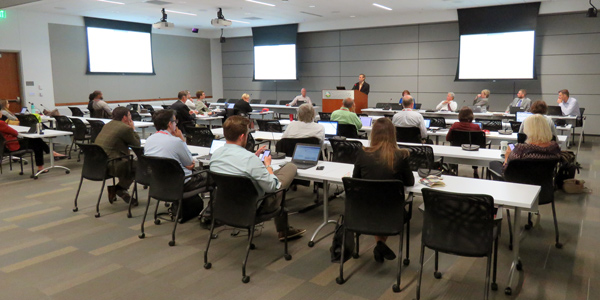By Jason Fordney
FOLSOM, Calif. — CAISO is going back to the drawing board to overhaul its reliability-must-run program, switching to a “holistic” approach after a more narrowly crafted backstop procurement proposal was rejected by FERC last month.
The ISO said it will combine into one process what was previously two separate phases of RMR rule changes. It hopes to develop its new proposal and complete a stakeholder process in time for presentation to its Board of Governors in March 2019.

Johnson | © RTO Insider
“We’re not really talking about phases any more; this is really one big initiative,” CAISO Infrastructure and Regulatory Policy Manager Keith Johnson said during a stakeholder meeting Wednesday. Many stakeholders had previously urged CAISO to combine the two phases and tackle what are perceived to be wider problems with the RMR construct, but the ISO had favored a more incremental approach.
As out-of-market payments, RMRs have stirred controversy among ISO participants and prompted a larger debate about resource adequacy in California and whether current policies are appropriately incentivizing needed generation. Most recently, CAISO issued a May 15 market notice saying it will seek RMR designations for NRG Energy’s Ellwood and Ormond Beach units, which the company in March said it planned to retire. (See CAISO: New 2019 RMR Contracts Possible.) Environmental groups had cheered the news of the retirements.
FERC last month rejected CAISO’s proposal to make substantive changes to the separate but related Capacity Procurement Mechanism, which is similar to RMR in that it functions as a backstop to financially support needed generation. In its decision, the commission said the ISO needs to propose a more comprehensive package of reform for CPM. (See FERC Rejects CAISO CPM Proposal.)
The RMR program is used as a reliability tool when a generating unit wants to retire but is still needed for reliability. RMR participation is mandatory, and units receive payments based on their cost of service, while those units designated under the CPM participate on a voluntary basis and receive a capped market-based price. The ISO said it is not currently planning to merge the two processes.
Among the items being considered in the newly crafted RMR reform package are:
- Modifying compensation for both RMR and CPM;
- Subjecting RMR units to a must-offer requirement in the wholesale market;
- Providing flexible RA credits from RMR units; and
- Modifying cost allocation of CPM to reflect load migration.
Other goals include lowering banking costs for RMR invoicing, streamlining and automating the RMR settlement process and making interim changes to the pro forma RMR agreement.

CAISO is reworking its RMR program. | © RTO Insider
Whatever backstop procurement the ISO develops will have to conform to — and interact with — a package of RA reforms being developed by the California Public Utilities Commission. At the CPUC, the ISO is advocating enhancements to flexible RA capacity procurement requirements, establishing multiyear RA procurement and vetting appropriate load forecasting assumptions.
“The ISO does think the RA program could be refreshed,” Johnson said.
CAISO has said it is likely the RMR reforms will need to go to settlement. During Wednesday’s meeting, stakeholders discussed how to negotiate the terms of an agreement without having to go through a settlement process at FERC after the proposal is filed.
Mark Smith, vice president of government and regulatory affairs at Calpine, called for an increase in the scope of proceeding to include revising the RMR pro forma agreement, modifying transmission planning to prevent backstop procurement and other reforms.
“We have a difference of opinion from the ISO as to what defines holistic,” Smith said during a presentation.

Calpine’s Mark Smith, left, discusses RMR issues with Southern California Edison’s Eric Little. | © RTO Insider
Eric Little, manager of wholesale markets at Southern California Edison, said that RMR and CPM have become replacements for resources normally provided by RA. He also mentioned a must-offer requirement for RMR/CPM resources and said they should receive cost-based contracts plus a reasonable return.
“In addition, the compensation method that was once a trade-off of competitive market for capacity augmented by energy market rents will need to be made equivalent under a contract mechanism with the CAISO,” Little said during a presentation.
The ISO is also working on increasing transparency around retirements, saying it will drop confidentiality provisions around notices of retirement or mothballing of units to ensure market participants are aware. That change, which will only require a revision to the ISO’s generator management business practices manual rather than approval by the board, is due to be implemented by July 1.
CAISO plans to issue a new RMR straw proposal by June 26, with another stakeholder meeting July 11 to discuss the many complex issues around what will be a major change in its procurement policies.


